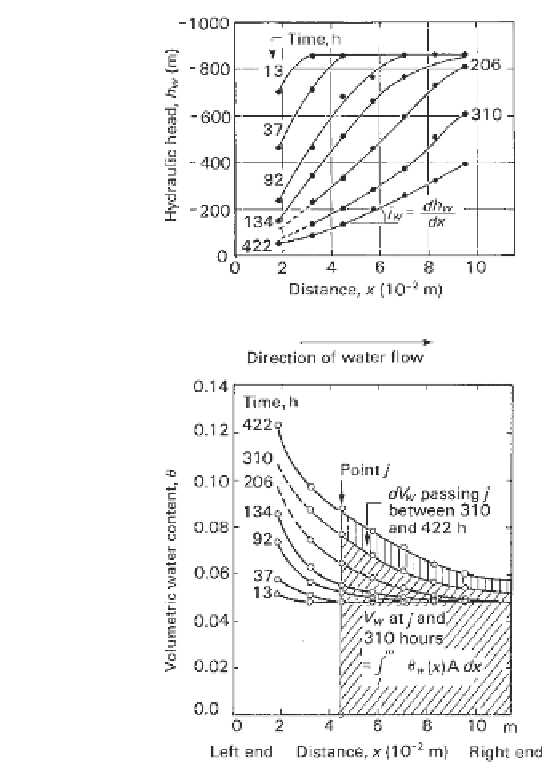Environmental Engineering Reference
In-Depth Information
The total volume of water present between point
j
and the
right end of the specimen (i.e., point
m
) at a specific time is
obtained by integrating the volumetric water content profile
over the specified time interval:
m
V
w
=
θ (x) Adx
(7.70)
j
where:
V
w
=
total volume of water in the soil between point
j
and the right end of the specimen designated as
point
m,
(a)
θ(x)
=
volumetric water content profile as a function of
distance
x
for a specific time, and
A
=
cross-sectional area of the specimen.
The difference in volumes of water,
dV
w
, computed
between two consecutive times (i.e., an interval
dt
)isthe
quantity of water flowing past point
j
during the time
interval under consideration (Fig. 7.33b). The flow rate at
the point is then computed as follows:
dV
w
Adt
v
w
=
(7.71)
The flow rate corresponds to an average value for the
hydraulic head gradients obtained at two consecutive times.
The coefficient of permeability
k
w
is computed by dividing
the flow rate
v
w
by the average hydraulic head gradient
i
ave
:
v
w
i
ave
k
w
=
(7.72)
(b)
Figure 7.33
Hydraulic head and water content profiles generated
during unsteady-state permeameter test: (a) profile of hydraulic
head along permeameter; (b) Profile of volumetric water content
along permeameter (after Hamilton et al., 1981).
Computations for the coefficient of permeability can
be repeated for different points and different times. As a
result, many coefficients of permeability can be computed
corresponding to various water contents or suction values
obtained from one test.
Figure 7.34 shows typical laboratory results of coeffi-
cient of permeability
k
w
for a clay as a function of suction.
The permeability test was performed using the instantaneous
profile method, and the data are presented in Fig. 7.33.
Test procedural problems that may be encountered using the
unsteady-state method are similar to those described previ-
ously for the steady-state method.
where:
i
w
=
hydraulic head gradient at a point for a specific
time and
dh
w
/
dx
=
slope of the hydraulic head profile at the point
under consideration.
The volumetric water content profile is obtained from the
measured pore-water pressures and the SWCC. The absolute
value of the negative pore-water pressure recorded by the
tensiometer is equal to the matric suction. The flow rate
v
w
at a point is equal to the volume of water that flows across
the cross-sectional area of the specimen,
A
, during a time
interval
dt.
Water flows from the left end of the permeameter
to the right end, and there is no water flow out of the right
end of the specimen. Therefore, the total volume of water
passing through a point in the soil specimen during a period
of time is equal to the water volume change that occurs
between the point under consideration and the right end of
the specimen during the specified time period.
7.6.3.3 Comparison between Drying Permeability
Function Obtained from Instantaneous Profile Method
and Indirect Statistical Methods
Experimental studies assist in assessing the reliability of var-
ious methods that can be used for the determination of the
permeability function for an unsaturated soil. Following are
the results of a comparison between one of the proposed
methods for the estimation of the permeability functions and
results obtained using an instantaneous profile method anal-
ysis on a model slope. The study was reported by Krisdani










Search WWH ::

Custom Search